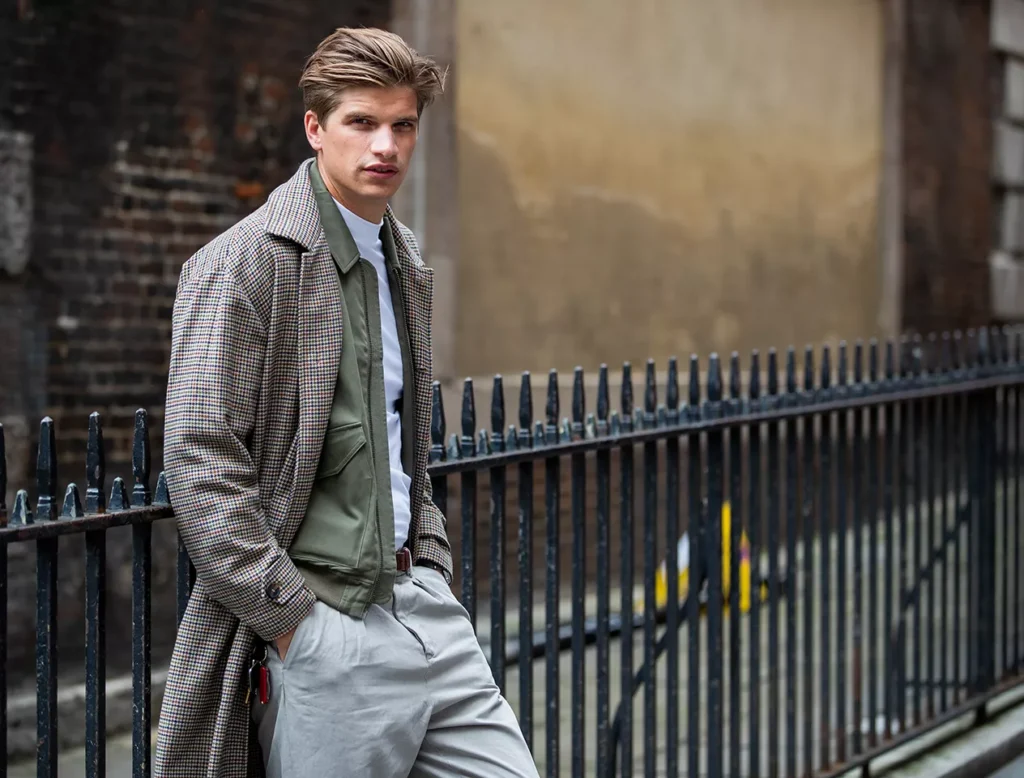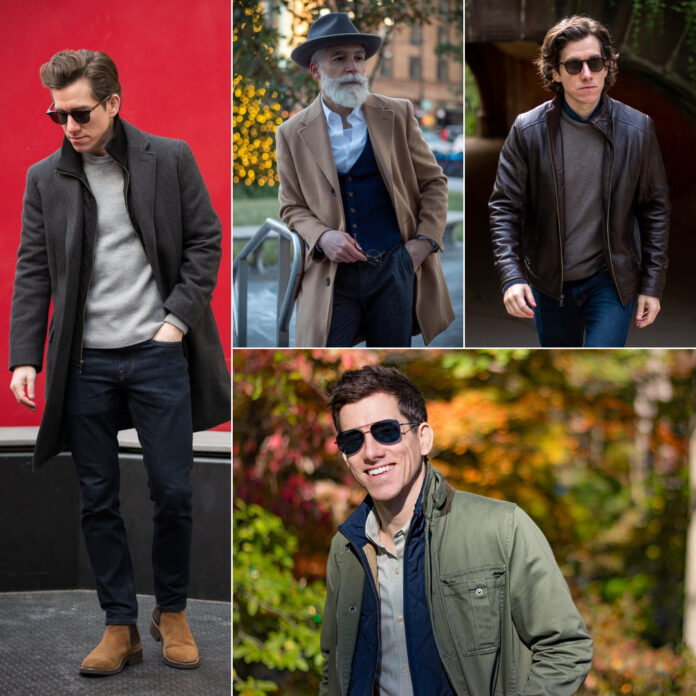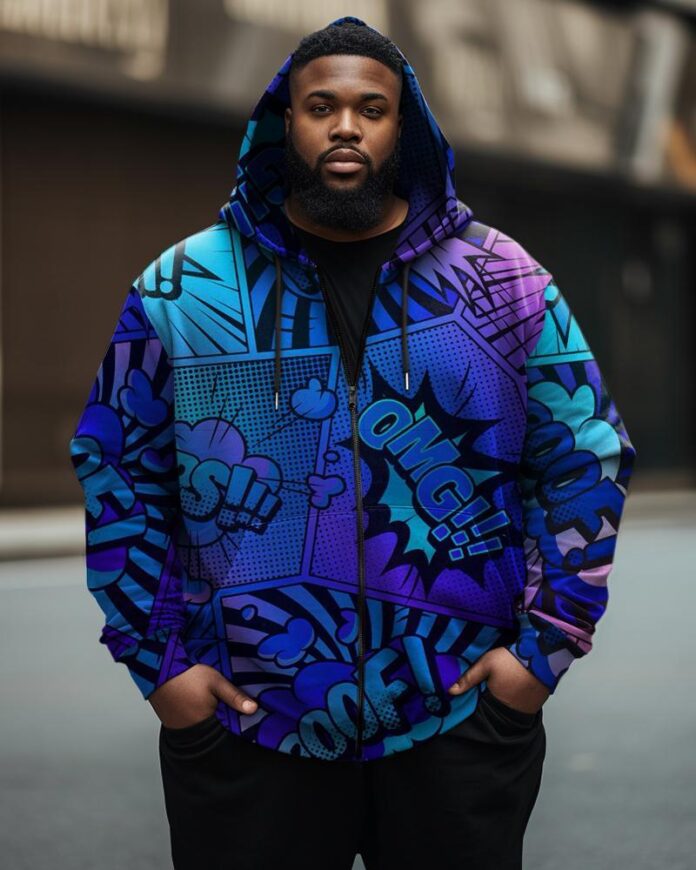
Layering, a key concept in men’s fashion, is the art of wearing multiple clothing items in a stylish and practical manner. It’s not only a technique to adjust to changing weather conditions but also a way to add depth, versatility, and interest to an outfit.
To help you master this essential skill in men’s fashion, we will explore the basics of layering, selecting suitable materials, color coordination, and much more.
Table of Contents
Why Layering?

Layering is more than just a practical approach to dressing. It’s a fashion statement that provides several advantages. You can use this skill to decide on your corporate attire, outdoor getups, groom suit combination, or casual wear.
This skill provides a functional solution for dealing with changing weather conditions. With multiple layers, you can effortlessly adjust your attire based on the weather. On a chilly morning, you might start with a T-shirt, add a sweater, and top it off with a jacket. As the day warms up, you can remove layers to stay comfortable.
Layering also enhances personal style by adding depth and complexity to an outfit. It allows you to mix and match different clothing items, creating unique combinations that showcase your individuality. Layering can transform a simple look into a fashion-forward ensemble, making you stand out.
On top of all these, layering is a cost-effective way to maximize your wardrobe. By creatively layering pieces, you can create diverse looks without constantly buying new clothes.
Understanding the Basics of Layering
Layering essentially involves three key layers: the base layer, the middle layer, and the outer layer. Each layer has a specific role and function:
- Base Layer- This is the layer closest to your skin. It’s typically a lightweight piece like a t-shirt or a dress shirt. The main function of this layer is to provide comfort and manage moisture. Materials that are soft and breathable, like cotton or bamboo, are ideal for this layer.
- Middle Layer- This layer is all about insulation. It keeps you warm by trapping heat close to your body. Sweaters, cardigans, and vests work well as middle layers. Here, you’ll want to choose a slightly heavier material than your base layer but not as heavy as your outer layer. Materials with good insulating properties, such as wool or fleece, are perfect for this layer.
- Outer Layer- The final layer, also known as the shell layer, protects you from external weather elements like wind, rain, or snow. Coats, jackets, and blazers are common outer layer choices. Depending on the weather, you might choose a waterproof raincoat, a wind-resistant jacket, or a heavy-duty winter coat.
Color Coordination and Patterns

Mastering the art of layering also involves skillful color coordination and pattern mixing. It’s about creating a harmonious balance that’s visually appealing.
Start with a neutral base – whites, blacks, grays, or beiges are usually safe bets. They provide a canvas for you to build upon. Next, introduce colors in your middle layer. You could opt for a bold red cardigan or perhaps a cool blue denim jacket.
For patterns, moderation is key. If your base layer has stripes, keep the rest simple. Alternatively, a patterned scarf could add a dash of personality to a solid-colored ensemble.
A classic example of successful layering is a white t-shirt paired with a black leather jacket and a gray scarf. The colors are coordinated, the patterns are minimal, and each layer serves a purpose.
Layering for Different Occasions
Now, let’s look into how you can utilize layering to create stylish, comfortable, and appropriate outfits for any occasion.
- Casual Layering- Mastering the art of casual layering can elevate your everyday style. Start with a basic tee or a polo shirt as your base layer. Add a lightweight button-down shirt or a cable knit sweater, depending on the weather. Finally, top it off with a denim or bomber jacket for added warmth and style. Remember, play with color contrasts and textures to keep the look interesting.
- Formal Layering-For formal settings, layers should maintain a refined and polished aesthetic. Begin with a crisp dress shirt, followed by a sleek waistcoat or a cashmere v-neck sweater. Finish with a well-tailored blazer or suit jacket. Keep colors neutral and patterns subtle for a professional appearance.
- Seasonal Layering- Adapting layers to seasons is crucial for comfort and appropriateness. In summer, opt for light materials like linen and cotton. Fall calls for medium layers like flannel shirts and light jackets. In winter, heavy sweaters, coats, and scarves become essential. Spring allows for a mix of light and medium layers, perfect for transitioning into warmer weather. Always consider the climate and adjust your layers accordingly.
Common Layering Mistakes and How to Overcome Them

Let’s get real about layering. It’s a necessary skill for men, but it can be tricky to master. You might have tried it before and ended up feeling more like a marshmallow than a style maven. Don’t worry, we’ve all been there. But with a few key tips, you can avoid the common layering pitfalls and step up your everyday getups.
One challenge you might face is the temptation to pile on too many heavyweight items. We’ve all seen that guy who looks like he’s wearing his entire wardrobe at once, right? The key to avoiding this is balance. Start with a lightweight t-shirt, add a mid-weight shirt, and finish off with a chunky sweater. This gives you the warmth and depth you’re after without the bulk.
Another potential misstep is going overboard with colors. Layering is a great opportunity to play with different hues, but too many at once can create a visual overload. To keep things cohesive, try sticking to a complementary color palette. Neutral tones make a great base, and then you can add a pop of color or two for a bit of personality.
And let’s not forget about texture. It’s a fantastic way to add interest to your outfit, but too many textures can make your look feel disjointed. A good rule of thumb is to stick to two or three different textures in one outfit. Additionally, there are various apps available that can help you experiment with different textures and styles to enhance your overall look. These apps for outfit can provide inspiration, suggest outfit combinations, and offer virtual try-on features, making it easier for you to curate a stylish and well-textured ensemble.
Takeaway
Layering is an opportunity to play with textures, colors, and patterns to create a look that’s uniquely yours. Don’t be afraid to experiment and push the boundaries of your comfort zone. After all, fashion is about expressing yourself, and layering is a fantastic way to do just that. So go ahead, mix it up, layer it on, and discover your own unique style in the process.















![16 Best Men’s Loafers 2023 [ BEST PREMIUM BRANDS ] best mens loafers](https://www.menshairstylesx.com/wp-content/uploads/2019/10/best-mens-loafers-1-100x70.jpg)
